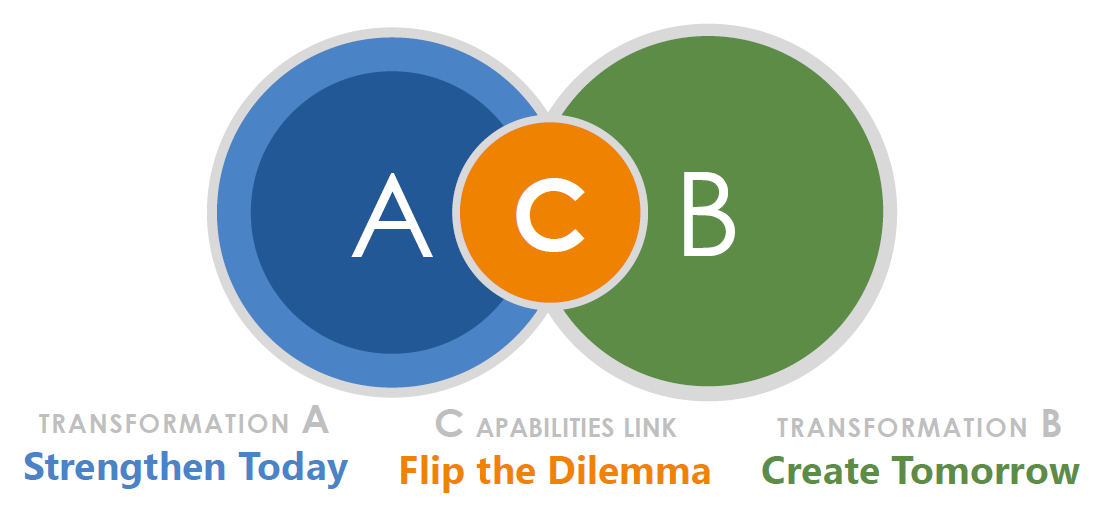Here is a chart, shown by Scott Anthony from Innosight during a worthwile talk on ‘Dual Transformation’ in July this year. It puts in a nutshell what he refers to as the “hardest challenge in business today”:
Simultaneously strengthening today’s business while creating tomorrow’s.
The chart greatly captures the fact that dual transformation involves three distinct playing fields:
- Transformation A: Strengthen Today
- Transformation B: Create Tomorrow
- Capabilities Link C: Flip the Dilemma
Scott Anthony further suggests five key actions for coping with field C through capabilities exchange and resource sharing between A and B:
- Be selective – only link capabilities that incite competitor jealousy or startup envy
- Be vigilant – watch out for hidden “DNA carriers” like spreadsheets and brands
- Be focused – “A does A and B does B”
- Be structured – consider exchange teams, transfer pricing, or portfolio systems
- Be active – top leadership actively arbitrates with a bias towards B
This framework underpins the trichotomy outlined earlier in the dual corporate innovation model, connecting the concepts of “organizational ambidexterity” and “three horizons”:
- H1: Optimization of existing businesses
- H3: Development of new businesses
- H2: Interface/linkage between H1 and H3, involving adaptation of existing businesses and scaling of new ones
Given this delineation, scaling activities in H2 largely address taking advantage of existing H1 core capabilities and resources. Conversely, adaptation activities to prolong core businesses – commonly often referred to as ‘business development’ – seek to draw on new capabilities and resources, many of which have started out in H3.
Case in point: Development of new, digital business models vs. Digitalization of existing business models.
[Amendment 30.03.17] With that said, it’s this interfacial middle ground H2 that makes or breaks corporate innovation and transformation activities. It’s even fair to declare it as most critical horizon to the success of such initiatives.
Takeaway
Implementing appropriate dual innovation or transformation setups entails gearing up for a trinity of distinct playing fields, each of which exhibits characteristic objectives and requirements. While established companies traditionally get A/H1 and meanwile increasingly get C/H3 (at least at the outset) right, field B/H2 still seems to a great extent uncharted territory for most of them – except for basic business development activities. This holds in particular true for major business model or operating model extensions and as far as scaling of new ventures is concerned. In most corporate approaches I have encountered up to now, these measures and the corresponding capability/resource exchange have been underestimated, underdeveloped or not even systematically addressed at all.
With that said, let’s conclude with Henry Chesbrough, upon being asked where he sees the biggest innovation challenge for established corporations. His answer greatly backs our recently launched “Scaling Up” initiative:
This connection between the front end of the innovation process and the back end […] is an area that really needs a lot of attention.









No comments yet.